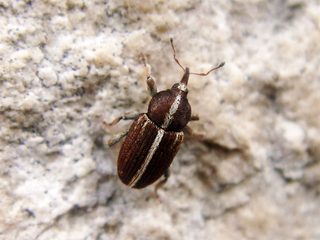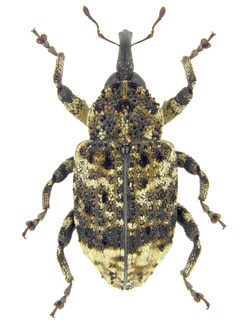
The Curculionidae are a family of weevils, commonly called snout beetles or true weevils. They are one of the largest animal families, with 6,800 genera and 83,000 species described worldwide. They are the sister group to the family Brentidae.

The boll weevil is a beetle that feeds on cotton buds and flowers. Thought to be native to Central Mexico, it migrated into the United States from Mexico in the late 19th century and had infested all U.S. cotton-growing areas by the 1920s, devastating the industry and the people working in the American South. During the late 20th century, it became a serious pest in South America as well. Since 1978, the Boll Weevil Eradication Program in the U.S. allowed full-scale cultivation to resume in many regions.

Weevils are beetles belonging to the superfamily Curculionoidea, known for their elongated snouts. They are usually small, less than 6 mm in length, and herbivorous. Approximately 97,000 species of weevils are known. They belong to several families, with most of them in the family Curculionidae. It also includes bark beetles, which while morphologically dissimilar to other weevils in lacking the distinctive snout, is a subfamily of Curculionidae. Some other beetles, although not closely related, bear the name "weevil", such as the biscuit weevil, which belongs to the family Ptinidae.
Ambrosia beetles are beetles of the weevil subfamilies Scolytinae and Platypodinae, which live in nutritional symbiosis with ambrosia fungi. The beetles excavate tunnels in dead, stressed, and healthy trees in which they cultivate fungal gardens, their sole source of nutrition. After landing on a suitable tree, an ambrosia beetle excavates a tunnel in which it releases spores of its fungal symbiont. The fungus penetrates the plant's xylem tissue, extracts nutrients from it, and concentrates the nutrients on and near the surface of the beetle gallery. Ambrosia fungi are typically poor wood degraders, and instead utilize less demanding nutrients. The majority of ambrosia beetles colonize xylem of recently dead trees, but some attack stressed trees that are still alive, and a few species attack healthy trees. Species differ in their preference for different parts of trees, different stages of deterioration, and in the shape of their tunnels ("galleries"). However, the majority of ambrosia beetles are not specialized to any taxonomic group of hosts, unlike most phytophagous organisms including the closely related bark beetles. One species of ambrosia beetle, Austroplatypus incompertus exhibits eusociality, one of the few organisms outside of Hymenoptera and Isoptera to do so.

Polyphaga is the largest and most diverse suborder of beetles. It comprises 144 families in 16 superfamilies, and displays an enormous variety of specialization and adaptation, with over 350,000 described species, or approximately 90% of the beetle species so far discovered.

The bean weevils or seed beetles are a subfamily (Bruchinae) of beetles, now placed in the family Chrysomelidae, though they have historically been treated as a separate family. They are granivores, and typically infest various kinds of seeds or beans, living most of their lives inside a single seed. The subfamily includes about 1,650 species and are found worldwide.

The beetle subfamily Curculioninae is part of the weevil family Curculionidae. It contains over 23,500 described species in 2,200 genera, and is therefore the largest weevil subfamily. Given that the beetle order (Coleoptera) contains about one-quarter of all known organisms, the Curculioninae represent one of the – if not the – most successful radiations of terrestrial Metazoa.

Centaurea solstitialis, the yellow star-thistle, is a species of thorny plant in the genus Centaurea, which is part of the family Asteraceae. A winter annual, it is native to the Mediterranean Basin region and invasive in many other places. It is also known as golden starthistle, yellow cockspur and St. Barnaby's thistle.

Chamaerops is a genus of flowering plants in the family Arecaceae. The only currently fully accepted species is Chamaerops humilis, variously called European fan palm or the Mediterranean dwarf palm. It is one of the most cold-hardy palms and is used in landscaping in temperate climates.

Belidae is a family of weevils, called belids or primitive weevils because they have straight antennae, unlike the "true weevils" or Curculionidae which have geniculate (elbowed) antennae. They are sometimes known as "cycad weevils", but this properly refers to a few species from the genera Parallocorynus and Rhopalotria.

Brentidae is a cosmopolitan family of primarily xylophagous beetles also known as straight-snouted weevils. The concept of this family has been recently expanded with the inclusion of three groups formerly placed in the Curculionidae; the subfamilies Apioninae, Cyladinae, and Nanophyinae, as well as the Ithycerinae, previously considered a separate family. They are most diverse in the tropics, but occur throughout the temperate regions of the world. They are among the families of weevils that have non-elbowed antennae, and tend to be elongate and flattened, though there are numerous exceptions.

Anthribidae is a family of beetles also known as fungus weevils. The antennae are not elbowed, may occasionally be longer than the body and thread-like, and can be the longest of any members of Curculionoidea. As in the Nemonychidae, the labrum appears as a separate segment to the clypeus, and the maxillary palps are long and projecting.

Cryptorhynchinae is a large subfamily of weevils (Curculionidae), with some 6000 species. They are found in most zoogeographic regions although they are most diverse in the Neotropics, Australia and Oceania.

The Attelabidae is a widespread family of weevils. They are among the primitive weevils, because of their straight antennae, which are inserted near the base of the rostrum. The prothorax is much narrower than the base of the elytra on the abdomen. Attelabidae and the related family Rhynchitidae are known commonly as the leaf-rolling weevils. Rhynchitidae may be treated as subfamily Rhynchitinae of the Attelabidae.

The palm weevil Rhynchophorus ferrugineus is one of two species of snout beetle known as the red palm weevil, Asian palm weevil or sago palm weevil. The adult beetles are relatively large, ranging between 2 and 4 centimetres long, and are usually a rusty red colour—but many colour variants exist and have often been classified as different species. Weevil larvae can excavate holes in the trunks of palm trees up to 1 metre (3.3 ft) long, thereby weakening and eventually killing the host plant. As a result, the weevil is considered a major pest in palm plantations, including the coconut palm, date palm and oil palm.
Elwood Curtin Zimmerman was an American entomologist best known for his two multivolume series: Insects of Hawaii published by the University of Hawaiʻi Press and Australian Weevils published by Australia's CSIRO.

The Entiminae are a large subfamily in the weevil family Curculionidae, containing most of the short-nosed weevils, including such genera as Entimus, Otiorhynchus, Phyllobius, Sitona, and Pachyrrhynchus. In comparison with their stunning diversity, only a few of these weevils are notorious pests of major economic importance. Entimines are commonly encountered in the field, including urban environments, and abundant in entomological collections.

Geonemini is a weevil tribe in the subfamily Entiminae.
Nealiolus curculionis is a species of parasitic wasp in the family Braconidae. It is a parasitoid of the sunflower stem weevil Cylindrocopturus adspersus, and a number of other species of stem-boring weevils.
Diocalandra frumenti, commonly known as the palm weevil borer, the lesser coconut weevil, or four-spotted coconut weevil, is a species of weevil in the family Curculionidae. It occurs in Africa, Southern Asia and Northern Australia, and is a pest of coconut and other palm trees.
















